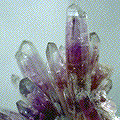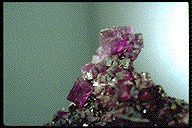Minerals by Name
Choose a letter of the alphabet from the above list, and the index list on the left will change to the list of minerals that begin with that letter. You may adjust the width and height of this window by using the border to the left or top.
The mineral name itself is a link to the description of that mineral species, while the number to the left is the approximate count of the number of specimens currently available for sale of that species, and is also a direct link to the list of specimens.
The count may be zero, but if the link is active then there are specimens available to view, just not currently for sale. If the count is zero and the link is not active, then there are not even any specimens in the database. Remember, there may be more than one page of specimens, so you may need to select Next Page one or more times to see the entire list of available specimens. This page is also available in a no frames version, as well as a single long alphabetic list.
The Most Common Minerals
- QUARTZ is undoubtedly the single most common mineral in the Earth's crust, ranging from perhaps 12% of continental crust to as much as 50% of oceanic crust as indicated by the composition of spreading-ridge volcanic lavas. Some estimates place quartz at 21% of the Earth's total lithosphere.
- FELDSPAR, (a group of related minerals) comprises the bulk of the Earth's crust, approximately 60% of the continental crust or 49% of the lithosphere. Perhaps 75% of this is the plagioclase feldspars (mostly albite, oligoclase and labradorite) with the remainder as potassium feldspars (mostly microcline and orthoclase).
- MICA (another group, primarily the minerals muscovite and biotite) comprises about 8% of the crust.
- OLIVINE (another group) is special. It's average composition mimics that of the bulk of the Earth - the mantle, which is nearly 1800 miles thick. Therefore, olivine is the most common mineral in the Earth, nearly 80% by volume, and that is a lot of peridot. It is the dense interior rock that the crust floats upon. Olivine is a major component of hot-spot volcanic lavas. About 15% of the crust is composed of olivines or their weathering/decomposition products, the PYROXENES (mostly augite) and the AMPHIBOLES (mostly hornblende).
- CALCITE comprises about 4% of the Earth's crust (but a lower percentage of the total lithosphere since it is unstable at the high temperatures of the inner mantle). It is important to note that the bulk of the Earth's carbon dioxide is tied up as calcium carbonate, otherwise the Earth's atmosphere might be 100 times as dense as at present and consist mostly of carbon dioxide, much like Venus (and with a similar impact on the planet).
- MAGNETITE is perhaps 3% of the crust.
- IRON, at least as the native element, is a nearly negligible component of the crust and the mantle, but the core of the earth is composed of a mixture of iron and nickel, and is, of course, mostly liquid. The inner core, approximately 1600 miles in diameter, is solid and thus qualifies as a mineral.










